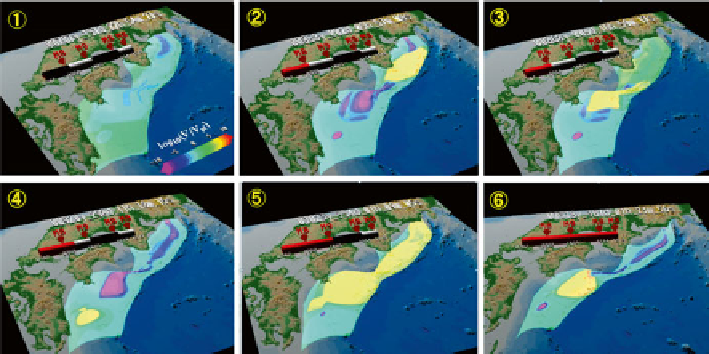Environmental Engineering Reference
In-Depth Information
Fig. 12.2
The result of recurrence cycle simulation. The
red
/
yellow
colors indicate earthquake
slips. (
1
) interseismic stage, (
2
) rupture of the eastern (Tokai) segment, (
3
) rupture of the western
(Nankai) segment, (
4
) the rupture of the M7 class earthquake, (
5
) the rupture of M9 class earth-
quake, (
6
) the rupture of the western segment
12.2.2
The Dense Ocean Floor Network for Earthquakes
and Tsunamis (DONET)
According to the previous researches, the Tonankai seismogenic zone is important
to understand the system of Nankai trough mega-thrust earthquake occurrences.
Therefore, we proposed and have been starting to deploy the dense ocean fl oor
observatory network system equipped with multi kinds of sensors such as seismom-
eters, pressure gauges etc. around the Tonankai seismogenic zone (Kawaguchi et al.
2012
; Kaneda
2013
). High-precision multi pressure gauges will be most useful sen-
sor to monitor ocean fl oor deformation with long term observation. This ocean fl oor
network was equipped with 20 observatories with seismometers and precise pres-
sure gauges.
This ocean fl oor deformation data will be applied to the data assimilation to
improve recurrence cycle simulation. This observatory system will be one of the
most advanced scientifi c tools to understand the mega thrust earthquakes around the
Nankai trough. This DONET system has useful functions and purposes as follows:
1. Redundancy, extension and advanced maintenance system using the looped
cable system, junction boxes and the ROV (remotely operated vehicle)/
AUV(autonomous underwater vehicle) etc. (Fig.
12.4
).
2. Multi kinds of sensors to observe wide range phenomena such as long period
tremors, low frequency earthquakes and strong motion of mega thrust earth-
quakes over M8 (Fig.
12.4
).
3. Speedy evaluation and notifi cation for earthquakes and tsunamis. This function
is the most important for disaster reduction /mitigation.

Search WWH ::

Custom Search